I am trying to make a Java port of a simple feed-forward neural network.
This obviously involves lots of numeric calculations, so I am trying to optimize my central loop as much as possible. The results should be correct within the limits of the float data type.
My current code looks as follows (error handling & initialization removed):
/**
* Simple implementation of a feedforward neural network. The network supports
* including a bias neuron with a constant output of 1.0 and weighted synapses
* to hidden and output layers.
*
* @author Martin Wiboe
*/
public class FeedForwardNetwork {
private final int outputNeurons; // No of neurons in output layer
private final int inputNeurons; // No of neurons in input layer
private int largestLayerNeurons; // No of neurons in largest layer
private final int numberLayers; // No of layers
private final int[] neuronCounts; // Neuron count in each layer, 0 is input
// layer.
private final float[][][] fWeights; // Weights between neurons.
// fWeight[fromLayer][fromNeuron][toNeuron]
// is the weight from fromNeuron in
// fromLayer to toNeuron in layer
// fromLayer+1.
private float[][] neuronOutput; // Temporary storage of output from previous layer
public float[] compute(float[] input) {
// Copy input values to input layer output
for (int i = 0; i < inputNeurons; i++) {
neuronOutput[0][i] = input[i];
}
// Loop through layers
for (int layer = 1; layer < numberLayers; layer++) {
// Loop over neurons in the layer and determine weighted input sum
for (int neuron = 0; neuron < neuronCounts[layer]; neuron++) {
// Bias neuron is the last neuron in the previous layer
int biasNeuron = neuronCounts[layer - 1];
// Get weighted input from bias neuron - output is always 1.0
float activation = 1.0F * fWeights[layer - 1][biasNeuron][neuron];
// Get weighted inputs from rest of neurons in previous layer
for (int inputNeuron = 0; inputNeuron < biasNeuron; inputNeuron++) {
activation += neuronOutput[layer-1][inputNeuron] * fWeights[layer - 1][inputNeuron][neuron];
}
// Store neuron output for next round of computation
neuronOutput[layer][neuron] = sigmoid(activation);
}
}
// Return output from network = output from last layer
float[] result = new float[outputNeurons];
for (int i = 0; i < outputNeurons; i++)
result[i] = neuronOutput[numberLayers - 1][i];
return result;
}
private final static float sigmoid(final float input) {
return (float) (1.0F / (1.0F + Math.exp(-1.0F * input)));
}
}
I am running the JVM with the -server option, and as of now my code is between 25% and 50% slower than similar C code. What can I do to improve this situation?
Thank you,
Martin Wiboe
Edit #1: After seeing the vast amount of responses, I should probably clarify the numbers in our scenario. During a typical run, the method will be called about 50.000 times with different inputs. A typical network would have numberLayers = 3 layers with 190, 2 and 1 neuron, respectively. The innermost loop will therefore have about 2*191+3=385 iterations (when counting the added bias neuron in layers 0 and 1)
Edit #1: After implementing the various suggestions in this thread, our implementation is practically as fast as the C version (within ~2 %). Thanks for all the help! All of the suggestions have been helpful, but since I can only mark one answer as the correct one, I will give it to @Durandal for both suggesting array optimizations and being the only one to precalculate the for loop header.
